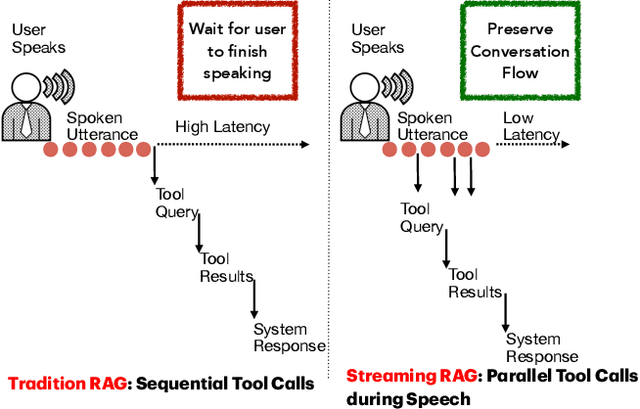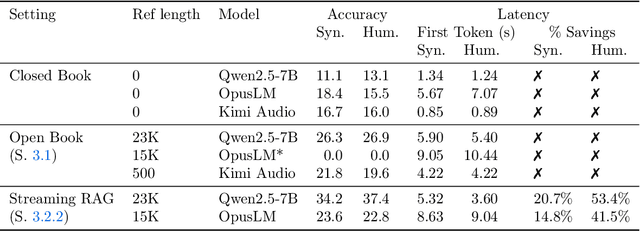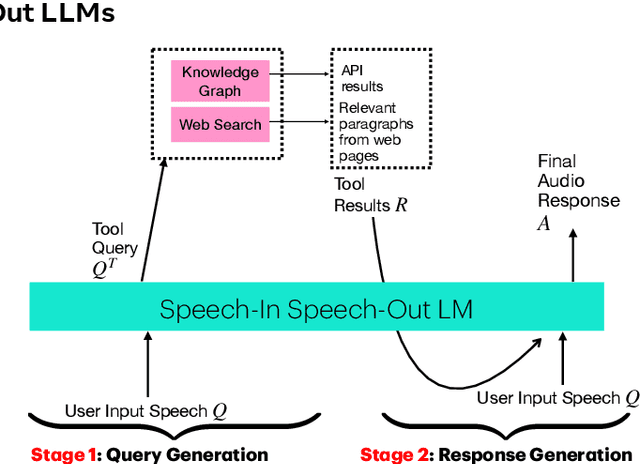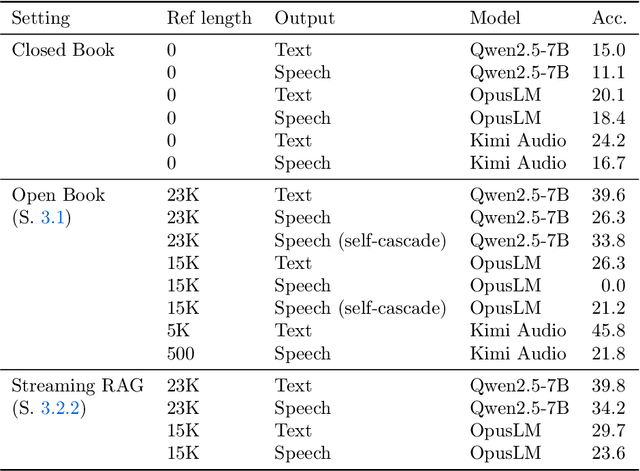Shinji Watanabe
Carnegie Mellon University
Full-Duplex-Bench-v2: A Multi-Turn Evaluation Framework for Duplex Dialogue Systems with an Automated Examiner
Oct 09, 2025Abstract:While full-duplex speech agents enable natural, low-latency interaction by speaking and listening simultaneously, their consistency and task performance in multi-turn settings remain underexplored. We introduce Full-Duplex-Bench-v2 (FDB-v2), a streaming framework that integrates with an automated examiner that enforces staged goals under two pacing setups (Fast vs. Slow). FDB-v2 covers four task families: daily, correction, entity tracking, and safety. We report turn-taking fluency, multi-turn instruction following, and task-specific competence. The framework is extensible, supporting both commercial APIs and open source models. When we test full-duplex systems with FDB-v2, they often get confused when people talk at the same time, struggle to handle corrections smoothly, and sometimes lose track of who or what is being talked about. Through an open-sourced, standardized streaming protocol and a task set, FDB-v2 makes it easy to extend to new task families, allowing the community to tailor and accelerate evaluation of multi-turn full-duplex systems.
Evaluating Self-Supervised Speech Models via Text-Based LLMS
Oct 06, 2025Abstract:Self-Supervised Learning (SSL) has gained traction for its ability to learn rich representations with low labeling costs, applicable across diverse downstream tasks. However, assessing the downstream-task performance remains challenging due to the cost of extra training and evaluation. Existing methods for task-agnostic evaluation also require extra training or hyperparameter tuning. We propose a novel evaluation metric using large language models (LLMs). By inputting discrete token sequences and minimal domain cues derived from SSL models into LLMs, we obtain the mean log-likelihood; these cues guide in-context learning, rendering the score more reliable without extra training or hyperparameter tuning. Experimental results show a correlation between LLM-based scores and automatic speech recognition task. Additionally, our findings reveal that LLMs not only functions as an SSL evaluation tools but also provides inference-time embeddings that are useful for speaker verification task.
Chain-of-Thought Reasoning in Streaming Full-Duplex End-to-End Spoken Dialogue Systems
Oct 02, 2025Abstract:Most end-to-end (E2E) spoken dialogue systems (SDS) rely on voice activity detection (VAD) for turn-taking, but VAD fails to distinguish between pauses and turn completions. Duplex SDS models address this by predicting output continuously, including silence tokens, thus removing the need for explicit VAD. However, they often have complex dual-channel architecture and lag behind cascaded models in semantic reasoning. To overcome these challenges, we propose SCoT: a Streaming Chain-of-Thought (CoT) framework for Duplex SDS, alternating between processing fixed-duration user input and generating responses in a blockwise manner. Using frame-level alignments, we create intermediate targets-aligned user transcripts and system responses for each block. Experiments show that our approach produces more coherent and interpretable responses than existing duplex methods while supporting lower-latency and overlapping interactions compared to turn-by-turn systems.
Stream RAG: Instant and Accurate Spoken Dialogue Systems with Streaming Tool Usage
Oct 02, 2025



Abstract:End-to-end speech-in speech-out dialogue systems are emerging as a powerful alternative to traditional ASR-LLM-TTS pipelines, generating more natural, expressive responses with significantly lower latency. However, these systems remain prone to hallucinations due to limited factual grounding. While text-based dialogue systems address this challenge by integrating tools such as web search and knowledge graph APIs, we introduce the first approach to extend tool use directly into speech-in speech-out systems. A key challenge is that tool integration substantially increases response latency, disrupting conversational flow. To mitigate this, we propose Streaming Retrieval-Augmented Generation (Streaming RAG), a novel framework that reduces user-perceived latency by predicting tool queries in parallel with user speech, even before the user finishes speaking. Specifically, we develop a post-training pipeline that teaches the model when to issue tool calls during ongoing speech and how to generate spoken summaries that fuse audio queries with retrieved text results, thereby improving both accuracy and responsiveness. To evaluate our approach, we construct AudioCRAG, a benchmark created by converting queries from the publicly available CRAG dataset into speech form. Experimental results demonstrate that our streaming RAG approach increases QA accuracy by up to 200% relative (from 11.1% to 34.2% absolute) and further enhances user experience by reducing tool use latency by 20%. Importantly, our streaming RAG approach is modality-agnostic and can be applied equally to typed input, paving the way for more agentic, real-time AI assistants.
CS-FLEURS: A Massively Multilingual and Code-Switched Speech Dataset
Sep 17, 2025Abstract:We present CS-FLEURS, a new dataset for developing and evaluating code-switched speech recognition and translation systems beyond high-resourced languages. CS-FLEURS consists of 4 test sets which cover in total 113 unique code-switched language pairs across 52 languages: 1) a 14 X-English language pair set with real voices reading synthetically generated code-switched sentences, 2) a 16 X-English language pair set with generative text-to-speech 3) a 60 {Arabic, Mandarin, Hindi, Spanish}-X language pair set with the generative text-to-speech, and 4) a 45 X-English lower-resourced language pair test set with concatenative text-to-speech. Besides the four test sets, CS-FLEURS also provides a training set with 128 hours of generative text-to-speech data across 16 X-English language pairs. Our hope is that CS-FLEURS helps to broaden the scope of future code-switched speech research. Dataset link: https://huggingface.co/datasets/byan/cs-fleurs.
MAPSS: Manifold-based Assessment of Perceptual Source Separation
Sep 11, 2025Abstract:Objective assessment of source-separation systems still mismatches subjective human perception, especially when leakage and self-distortion interact. We introduce the Perceptual Separation (PS) and Perceptual Match (PM), the first pair of measures that functionally isolate these two factors. Our intrusive method begins with generating a bank of fundamental distortions for each reference waveform signal in the mixture. Distortions, references, and their respective system outputs from all sources are then independently encoded by a pre-trained self-supervised learning model. These representations are aggregated and projected onto a manifold via diffusion maps, which aligns Euclidean distances on the manifold with dissimilarities of the encoded waveforms. On this manifold, the PM measures the Mahalanobis distance from each output to its attributed cluster that consists of its reference and distortions embeddings, capturing self-distortion. The PS accounts for the Mahalanobis distance of the output to the attributed and to the closest non-attributed clusters, quantifying leakage. Both measures are differentiable and granular, operating at a resolution as low as 50 frames per second. We further derive, for both measures, deterministic error radius and non-asymptotic, high-probability confidence intervals (CIs). Experiments on English, Spanish, and music mixtures show that the PS and PM nearly always achieve the highest linear correlation coefficients with human mean-opinion scores than 14 competitors, reaching as high as 86.36% for speech and 87.21% for music. We observe, at worst, an error radius of 1.39% and a probabilistic 95% CI of 12.21% for these coefficients, which improves reliable and informed evaluation. Using mutual information, the measures complement each other most as their values decrease, suggesting they are jointly more informative as system performance degrades.
The ML-SUPERB 2.0 Challenge: Towards Inclusive ASR Benchmarking for All Language Varieties
Sep 08, 2025



Abstract:Recent improvements in multilingual ASR have not been equally distributed across languages and language varieties. To advance state-of-the-art (SOTA) ASR models, we present the Interspeech 2025 ML-SUPERB 2.0 Challenge. We construct a new test suite that consists of data from 200+ languages, accents, and dialects to evaluate SOTA multilingual speech models. The challenge also introduces an online evaluation server based on DynaBench, allowing for flexibility in model design and architecture for participants. The challenge received 5 submissions from 3 teams, all of which outperformed our baselines. The best-performing submission achieved an absolute improvement in LID accuracy of 23% and a reduction in CER of 18% when compared to the best baseline on a general multilingual test set. On accented and dialectal data, the best submission obtained 30.2% lower CER and 15.7% higher LID accuracy, showing the importance of community challenges in making speech technologies more inclusive.
Learning Robust Spatial Representations from Binaural Audio through Feature Distillation
Aug 28, 2025Abstract:Recently, deep representation learning has shown strong performance in multiple audio tasks. However, its use for learning spatial representations from multichannel audio is underexplored. We investigate the use of a pretraining stage based on feature distillation to learn a robust spatial representation of binaural speech without the need for data labels. In this framework, spatial features are computed from clean binaural speech samples to form prediction labels. These clean features are then predicted from corresponding augmented speech using a neural network. After pretraining, we throw away the spatial feature predictor and use the learned encoder weights to initialize a DoA estimation model which we fine-tune for DoA estimation. Our experiments demonstrate that the pretrained models show improved performance in noisy and reverberant environments after fine-tuning for direction-of-arrival estimation, when compared to fully supervised models and classic signal processing methods.
Geolocation-Aware Robust Spoken Language Identification
Aug 23, 2025Abstract:While Self-supervised Learning (SSL) has significantly improved Spoken Language Identification (LID), existing models often struggle to consistently classify dialects and accents of the same language as a unified class. To address this challenge, we propose geolocation-aware LID, a novel approach that incorporates language-level geolocation information into the SSL-based LID model. Specifically, we introduce geolocation prediction as an auxiliary task and inject the predicted vectors into intermediate representations as conditioning signals. This explicit conditioning encourages the model to learn more unified representations for dialectal and accented variations. Experiments across six multilingual datasets demonstrate that our approach improves robustness to intra-language variations and unseen domains, achieving new state-of-the-art accuracy on FLEURS (97.7%) and 9.7% relative improvement on ML-SUPERB 2.0 dialect set.
Music Arena: Live Evaluation for Text-to-Music
Jul 28, 2025Abstract:We present Music Arena, an open platform for scalable human preference evaluation of text-to-music (TTM) models. Soliciting human preferences via listening studies is the gold standard for evaluation in TTM, but these studies are expensive to conduct and difficult to compare, as study protocols may differ across systems. Moreover, human preferences might help researchers align their TTM systems or improve automatic evaluation metrics, but an open and renewable source of preferences does not currently exist. We aim to fill these gaps by offering *live* evaluation for TTM. In Music Arena, real-world users input text prompts of their choosing and compare outputs from two TTM systems, and their preferences are used to compile a leaderboard. While Music Arena follows recent evaluation trends in other AI domains, we also design it with key features tailored to music: an LLM-based routing system to navigate the heterogeneous type signatures of TTM systems, and the collection of *detailed* preferences including listening data and natural language feedback. We also propose a rolling data release policy with user privacy guarantees, providing a renewable source of preference data and increasing platform transparency. Through its standardized evaluation protocol, transparent data access policies, and music-specific features, Music Arena not only addresses key challenges in the TTM ecosystem but also demonstrates how live evaluation can be thoughtfully adapted to unique characteristics of specific AI domains. Music Arena is available at: https://music-arena.org
 Add to Chrome
Add to Chrome Add to Firefox
Add to Firefox Add to Edge
Add to Edge